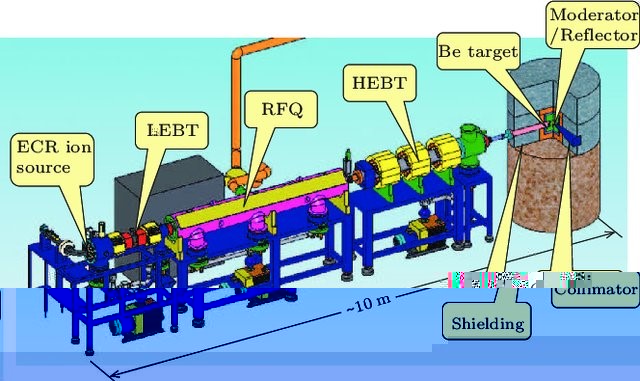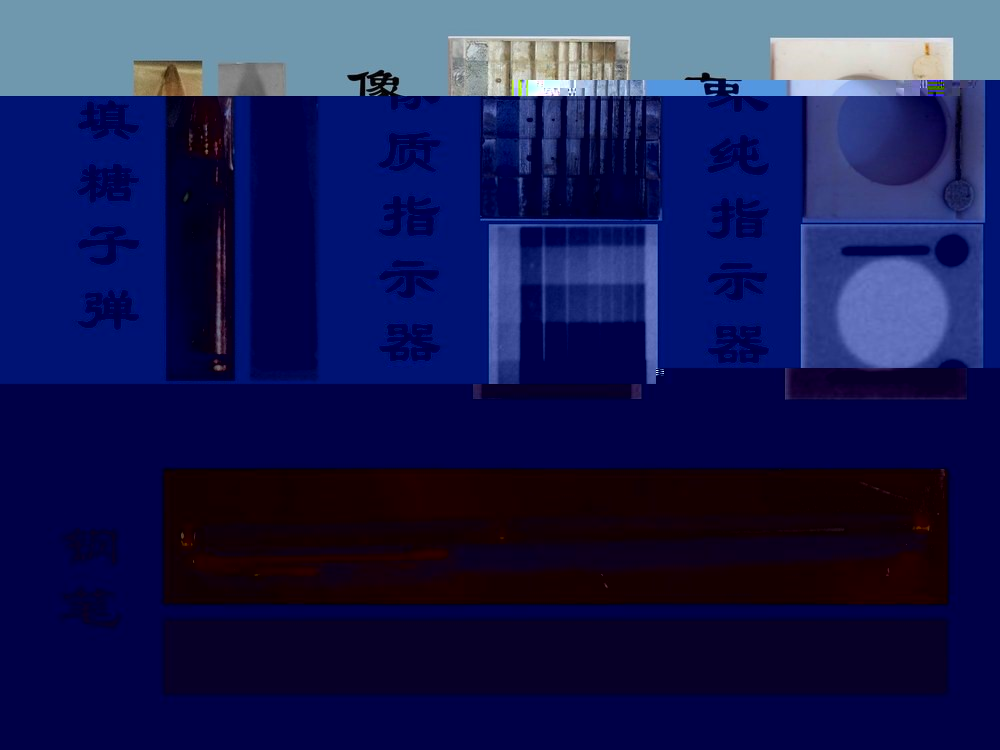中子照相已被廣泛應用于許多學科,從物理,生命和地球科學的材料研究到工業組件和文物的無損檢測。目前,大多數中子照相設備都是基于反應堆中子源和散裂中子源,它們可以提供高的中子通量和高質量的熱中子束。然而,在某些情況下,人們希望擁有一個緊湊型加速器驅動的中子源(CANS)的中子照相設備,并且可以在現場使用,甚至可以移動。這意味着它的尺寸盡可能小,并且其成本盡可能低。
beat365中子照相裝置(PKUNITY)是基于RFQ加速器驅動的緊湊型中子源,目前已經在beat365建造和調試完成。該項目建成了我國首台基于加速器的現場中子照相裝置,系統地開展了針對碳/碳複合材料中子射線檢測方法的研究,并實現了中子數字成像,獲得了工程化的初步成果。在中子照相适用性研究方法、RFQ中子發生器技術、中子照相裝置設計等方面具有創新性。
該裝置基于一台強流RFQ加速器(Table 2),通過氘-铍核反應産生中子,快中子産額為2.4×1011n/s。成像平面上的熱中子通量在L / D比為50時為2.35×104n/cm2/s,并且L / D比可在25-200的範圍内選擇,相應的n/γ比接近或高于1×1010 n/cm2/Sv。在準直器入口孔下遊2m處的視野為20cm×20cm,其中熱中子通量均勻性優于7%。Table 1.列出了PKUNITY的主要技術參數。
The method of neutron radiography has been widely used in many disciplines, from materials research in physical, life and earth sciences to non-destructive characterization of industrial components and artifacts of cultural heritage. Currently most of the neutron radiography facilities are based on the reactor neutron source and spallation neutron source, which can give intense neutron flux and high quality neutron radiographs. However, in some cases people would like to have a neutron radiography facility, which is based on a compact accelerator-driven neutron source (CANS), and can be used on the spot or even can be movable. That means its size is as small as possible, and its cost is as low as possible.
The Peking University Neutron Imaging Facility (PKUNIFTY), based on RFQ accelerator-driven compact neutron source, has been constructed and commissioned at Peking University. The project has built the first accelerator-based neutron radiography facility in China, systematically carried out research on neutron radiation detection methods for carbon/carbon composite materials, and realized neutron digital imaging, and obtained preliminary results of engineering. It is innovative in neutron radiography applicability research methods, RFQ neutron generator technology, and the design of neutron radiography facility.
The device is based on a high-current RFQ accelerator (Table 2). Neutrons are generated via the deuteron-beryllium reaction with a fast neutron yield of 2.4×1011n/s. The thermal neutron flux on the imaging plane is 2.35×104n/cm2/s at a nominal L/D ratio of 50, and the L/D ratio can be selectable over a range of 25-200. The corresponding n/γ ratio is close to or higher than 1×1010 n/cm2/Sv. The field of view is 20cm×20 cm at 2m downstream of the collimator entrance aperture where the thermal neutron flux uniformity is better than 7%. The main technical parameters of PKUNITY are listed in Table 1.

Fig 1. Outline of PKUNITY
Table 1. Technical Parameters of PKUNIFTY

PKUNITY由三個子系統組成。
(a) 加速器(Fig 2.):加速器包括ECR離子源,低能束流傳輸段(LEBT),RFQ腔和高能束流傳輸段(HEBT),出口能量2MeV,平均流強4mA。
(b) 靶-慢化劑-反射體組件(Fig 3):從Be靶發射出的快中子被慢化劑慢化,慢化劑周圍的反射體将逃逸的快中子重新反射到慢化劑中,從而最終增加了熱中子的通量,準直器将成形的熱中子束傳輸到成像站。屏蔽體可以吸收從組件中逃逸出的中子和γ光子,用于人員和環境的輻射防護以及在數據收集中實現高信噪比。
(c) 成像系統:包括一個接收發射的中子并将其轉換成光的閃爍屏、兩個反射鏡以将光線從中子束中反射出去,以及一個透鏡和一個用于成像的冷卻式CCD相機。
The PKUNIFTY consists of three subsystems.
(a) The accelerator (Fig 2.): the accelerator includes an ECR deuteron ion source, a low energy beam transport (LEBT), a RFQ cavity and a high energy beam transport (HEBT). It generates a deuteron beam at 2MeV with an average current of 4mA.
(b) The target-moderator-reflector assembly (Fig 3.): the fast neutrons emitted from the beryllium target are slowed down by the moderator medium. The reflector around the moderator redirects some of the escaped fast neutrons back to the moderator, thereby enhancing the eventual thermal neutron intensity. A collimator facilitates a conduit for transporting the thermal neutrons with a shaped beam profile toward the imaging station. The shielding surrounding the target, moderator, and reflector capture and/or absorb the neutrons and g-rays from escaping outside the assembly for radiation protection of personnel and the environment as well as for realizing a high signal-to-noise ratio in data collection.
(c) The imaging system: it includes a scintillation screen that accepts the transmitted neutrons and converts them into light, two mirrors to reflect the light away from the neutron beam, and a lens and a cooled CCD camera for imaging.

Fig 2. The RFQ accelerator of PKUNIFTY
Table 2. Key parameters of the PKUNIFTY RFQ


Fig 3. Experimental platform diagram.
在我們的實驗中測試了如Fig 4. (a)所示的銅鎖。Fig 4. (b)顯示了它的中子照片,可以清楚地看到它的内部結構。然後我們注入了一些潤滑油,帶有油的照片Fig 4. (c)所示,圖中可以識别出油分布。Fig 5.顯示了其他的中子照相的實驗結果。
A copper lock, shown in Fig. 4(a), was tested in our experiments. Fig. 4(b) shows its neutron radiograph, in which its inner structure can be seen clearly. Then we inserted some lubricating oil, and the radiograph with oil is shown in Fig. 4(c), in which the oil distribution can be recognized. Fig 5. Shows the neutron radiography results of some other experiments.

Fig 4. The photo and neutron radiographs of a copper lock. (a) photo, (b) neutron radiograph with oil, (c) neutron radiograph with filled oil.

Fig 5. The neutron radiography results of other experiments.
